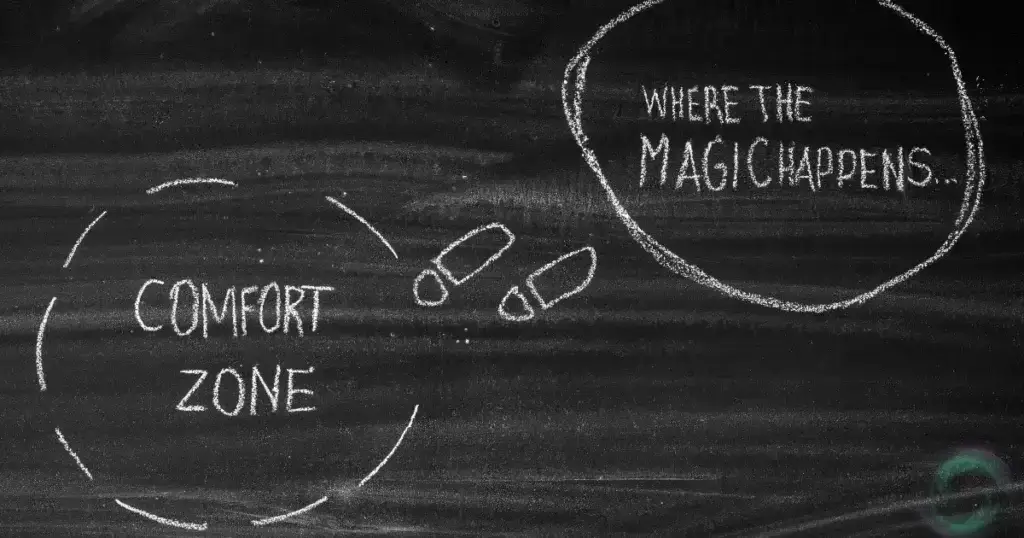From Fear to Flow: Mastering the Art of Reaching Your Growth Zone
Have you ever felt that nagging urge to try something new, but fear held you back? Or maybe you’re stuck in a rut, longing for progress but unsure where to begin. This is where understanding your comfort zone and the zones beyond it becomes crucial. It’s a roadmap to personal growth, filled with challenges and triumphs.

This article will guide you through the four key zones in your growth journey: comfort zone, fear zone, learning zone, and the ultimate destination – the growth zone. We’ll explore what each zone entails, how to navigate them, and ultimately, how to leverage them to reach your full potential.
The Comfort Zone: Familiar Territory
Imagine a cozy armchair – your comfort zone. It’s the familiar space where you feel safe, secure, and in control. Here, tasks come easily, routines are predictable, and there’s minimal risk of failure. While comfort offers peace of mind, it also stagnates growth. No new skills are developed, and your potential remains untapped.
Signs You’re Stuck in Your Comfort Zone:
The comfort zone can feel, well, comfortable. But it can also hold you back from reaching your full potential. Here are some signs you might be stuck there:
- Routine on repeat: Every day feels similar, with the same tasks and activities. You might even find yourself carrying over unfinished tasks because nothing new or exciting motivates you to tackle them.
- Negative self-talk: You find yourself thinking things like “I’m not good enough” or “I can’t do that.” This negativity can hold you back from even trying new things.
- Fear of failure: The possibility of messing up or not succeeding can be paralyzing, stopping you from taking chances or pursuing your goals.
- Rejection of new ideas: You might find yourself shutting down new ideas or opportunities, even if they sound interesting. This can be a sign that you’re afraid of change.
- General unhappiness: While comfort might seem positive, a nagging sense of dissatisfaction or a lack of fulfillment can indicate you’re not growing or being challenged.
- Settling for “good enough”: You might be in a job or relationship that’s okay, but not great. You might not be negotiating for raises or promotions, or asking for what you want out of life.
Stepping Outside Your Comfort Zone: The Fear Zone
Venturing beyond the comfort zone leads to the fear zone. This is where unfamiliarity and uncertainty take hold. You might experience apprehension, self-doubt, or even anxiety. Public speaking for the first time, learning a new language, or starting a creative project are all examples of stepping into the fear zone.
Signs You’re Stuck in Your Fear Zone:
Here are some signs you might be stuck in your fear zone:
- Avoiding New Things: You consistently reject opportunities that push you outside your comfort zone, even if they seem interesting. This could be anything from trying a new restaurant to going back to school.
- Constant Resistance to Change: Any kind of change, even positive ones, trigger negativity and resistance. You crave familiarity and stability, even if it feels a bit stagnant.
- Dwelling on Worst-Case Scenarios: You spend a lot of time imagining the negative outcomes of situations, even if they’re unlikely. This fear of failure can paralyze you from taking action.
- Lack of Growth: You feel stuck in a rut, neither learning nor progressing in your personal or professional life. There’s a sense that you’re not reaching your full potential.
- Envy of Others: You find yourself envying the achievements and experiences of others, but doubt your own ability to achieve similar things.
- Frequent Excuses: You readily come up with excuses to avoid challenges or opportunities that scare you. This might sound like, “I’m not good at that” or “The timing isn’t right.”
- Settling for Less: You accept situations that are less than ideal because the idea of rocking the boat or taking a risk feels too overwhelming.
If you recognize many of these signs in yourself, it might be a good time to consider stepping outside your comfort zone. Remember, a little fear is normal, but it shouldn’t hold you back from growth and new experiences.
The Fear Zone is Not Your Enemy
Fear is a natural response to the unknown. However, it shouldn’t be a permanent resident. Here are some tips to navigate the fear zone:
- Acknowledge Your Fear: Ignoring fear won’t make it disappear. Recognize it and understand its source.
- Break Down Challenges: Divide big goals into smaller, manageable steps, making them less intimidating.
- Focus on the Positive: Visualize success and the potential rewards of overcoming your fear.
The Learning Zone: Where Growth Begins
Pushing through fear leads to the learning zone. This is where the magic happens! Here, you actively engage with new skills and experiences. You might make mistakes, but that’s part of the learning process. Embrace challenges, seek feedback, and celebrate small wins.
Signs You’ve Entered The Learning Zone
Here are some signs you’ve entered the learning zone, that sweet spot where challenge meets focused engagement:
- Flow and Absorption: You’re completely absorbed in the task at hand, time seems to fly by, and you lose self-consciousness. This state of “flow” is a hallmark of being in the learning zone.
- Optimal Challenge: You feel challenged by the task, but not overwhelmed. It’s difficult enough to require focused effort, but achievable enough to keep you motivated.
- Curiosity and Inquiry: You’re filled with a sense of curiosity and a desire to understand the material. You ask questions, seek out new information, and actively engage with the learning process.
- Concentration and Focus: Distractions fade away, and you can maintain intense concentration for extended periods.
- Immediate Feedback: You’re getting immediate feedback on your performance, allowing you to adjust your approach and learn from mistakes. This could be from a teacher, practice problems, or even trial and error.
- A Sense of Effort and Reward: The learning process requires effort, but it’s also enjoyable and rewarding. You feel a sense of satisfaction as you master new skills and knowledge.
- Mistakes as Stepping Stones: You view mistakes as valuable learning opportunities, not failures. You’re willing to experiment and learn from your missteps.
If you’re experiencing many of these signs, congratulations! You’ve found the sweet spot for effective learning. Keep at it, and you’ll continue to grow and develop your skills.
The Learning Zone in Action:
- Taking a coding class: You might encounter errors, but with practice, you’ll gain coding proficiency.
- Learning a new instrument: It will sound rough initially, but consistent practice leads to beautiful melodies.
- Giving a presentation: You might stumble over words at first, but with each presentation, your delivery becomes smoother.
Embrace the Learning Zone:
- Seek Out Resources: Books, online courses, and mentors can be invaluable guides in the learning zone.
- Practice Makes Progress: Dedicate time to consistent practice and actively seek opportunities to apply what you’ve learned.
- Celebrate Milestones: Acknowledge and celebrate your progress, no matter how small.
The Growth Zone: The Sweet Spot
Finally, you reach the growth zone. This is where the discomfort of the fear zone transforms into the satisfaction of accomplishment. You’ve mastered new skills, expanded your abilities, and gained confidence. The growth zone is a state of continuous learning and personal development.
Signs You’ve Landed in The Growth Zone
Here are some signs you’ve landed in the Growth Zone, that ideal space where challenge and learning collide:
- Healthy Excitement and Apprehension: You feel a mix of excitement about the challenge and a touch of nervousness. It’s not paralyzing fear, but a healthy awareness that you’re pushing your boundaries.
- Increased Confidence: You trust your abilities and are eager to tackle new challenges.
- Resilience: You learn from setbacks and bounce back stronger.
- Full Engagement: You’re completely immersed in the activity, giving it your full focus and energy. The task is demanding your attention, but in a way that feels stimulating and rewarding.
- Learning Focus: Your primary concern is on the learning process itself, not just achieving a specific outcome. You’re actively seeking out new information and strategies to improve your skills.
- Effort Feels Manageable: While the task requires effort, it doesn’t feel overwhelming. You feel confident in your ability to learn and grow through the challenge.
- Mistakes as Stepping Stones: You see mistakes as inevitable and even valuable learning experiences. You’re willing to take risks and experiment, knowing that missteps are part of the growth process in the Growth Zone.
- Progress Over Perfection: You celebrate small wins and improvements, focusing on the journey of learning rather than the pressure of achieving immediate perfection.
- Seeking Feedback: You actively seek out constructive feedback to identify areas for improvement. You view feedback as a tool to help you learn and grow in the Growth Zone.
- Increased Confidence: As you master new skills and overcome challenges, your confidence in your abilities begins to grow. This newfound confidence fuels your motivation to keep learning and expanding your skillset.
If you’re experiencing many of these signs, then congratulations! You’ve landed in the Growth Zone, the prime spot for maximizing your learning and personal development.
Maintaining the Growth Zone:
- Set SMART Goals: Establish Specific, Measurable, Achievable, Relevant, and Time-bound goals to keep yourself motivated.
- Step Outside Your Comfort Zone Regularly: Don’t get complacent – continually challenge yourself with new experiences.
- Embrace a Growth Mindset: Believe that your abilities can develop through effort and dedication.
Ready to embark on your growth journey?
Here are some actionable steps to get you started:
| ❖ Identify an area you’d like to grow in. ❖ Set a SMART goal for yourself. ❖ Research resources (courses, mentors, tutorials) to achieve your learning goal. ❖ Break your goal into smaller steps to track progress and feel less overwhelmed. ❖ Find an accountability partner for support and encouragement. ❖ Step outside your comfort zone gradually, starting with manageable challenges. ❖ Celebrate all wins to stay motivated. ❖ Embrace challenges as learning opportunities, analyze mistakes, and adjust your approach. ❖ Focus on the enjoyment of learning and growth, not just the final outcome. |
Remember, growth is a lifelong journey. By embracing the discomfort of the fear zone and the joy of the learning zone, you can unlock your full potential and create a life filled with continuous development and achievement.
Conclusion: Your Growth Journey Awaits
The journey from comfort zone to growth zone is a continuous cycle. As you reach a growth zone in one area, a new comfort zone is established. Then, the cycle begins again as you push yourself towards new challenges and experiences. Remember, growth is rarely linear. There will be setbacks and moments of doubt. But by embracing the learning zone and persevering through the fear zone, you unlock your full potential and create a life filled with continuous development and achievement.






